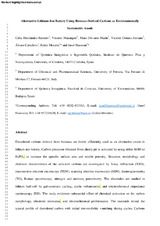Mostrar el registro sencillo del ítem
Alternative lithium-ion battery using biomass-derived carbons as environmentally sustainable anode
| dc.contributor.author | Hernández-Rentero, C. | |
| dc.contributor.author | Marangon, Vittorio | |
| dc.contributor.author | Olivares-Marín, Mara | |
| dc.contributor.author | Gómez-Serrano, Vicente | |
| dc.contributor.author | Caballero, Álvaro | |
| dc.contributor.author | Morales, Julián | |
| dc.contributor.author | Hassoun, Jusef | |
| dc.date.accessioned | 2022-03-10T12:37:42Z | |
| dc.date.available | 2022-03-10T12:37:42Z | |
| dc.date.issued | 2020 | |
| dc.identifier.uri | http://hdl.handle.net/10396/22671 | |
| dc.description.abstract | Disordered carbons derived from biomass are herein efficiently used as an alternative anode in lithium-ion battery. Carbon precursor obtained from cherry pit is activated by using either KOH or H3PO4, to increase the specific surface area and enable porosity. Structure, morphology and chemical characteristics of the activated carbons are investigated by X-ray diffraction (XRD), transmission electron microscopy (TEM), scanning electron microscopy (SEM), thermogravimetry (TG), Raman spectroscopy, nitrogen and mercury porosimetry. The electrodes are studied in lithium half-cell by galvanostatic cycling, cyclic voltammetry, and electrochemical impedance spectroscopy (EIS). The study evidences substantial effect of chemical activation on the carbon morphology, electrode resistance, and electrochemical performance. The materials reveal the typical profile of disordered carbon with initial irreversibility vanishing during cycles. Carbons activated by H3PO4 show higher capacity at the lower C-rates, while those activated by KOH reveal improved reversible capacity at the high currents, with efficiency approaching 100% upon initial cycles, and reversible capacity exceeding 175 mAh g−1. Therefore, the carbons and LiFePO4 cathode are combined in lithium-ion cells delivering 160 mAh g−1 at 2.8 V, with a retention exceeding 95% upon 200 cycles at C/3 rate. Hence, the carbons are suggested as environmentally sustainable anode for Li-ion battery. | es_ES |
| dc.format.mimetype | application/pdf | es_ES |
| dc.language.iso | eng | es_ES |
| dc.publisher | Elsevier | es_ES |
| dc.rights | https://creativecommons.org/licenses/by-nc-nd/4.0/ | es_ES |
| dc.source | Journal of Colloid and Interface Science 573, 396-408 (2020) | es_ES |
| dc.subject | Lithium-ion battery | es_ES |
| dc.subject | Biomass-derived | es_ES |
| dc.subject | Activated carbon | es_ES |
| dc.subject | Cherry pits | es_ES |
| dc.subject | LiFePO4 | es_ES |
| dc.title | Alternative lithium-ion battery using biomass-derived carbons as environmentally sustainable anode | es_ES |
| dc.type | info:eu-repo/semantics/article | es_ES |
| dc.relation.publisherversion | https://doi.org/10.1016/j.jcis.2020.03.092 | es_ES |
| dc.relation.projectID | Gobierno de España. MAT2017-87541-R | es_ES |
| dc.relation.projectID | Junta de Andalucía. FQM-175 | es_ES |
| dc.rights.accessRights | info:eu-repo/semantics/openAccess | es_ES |

